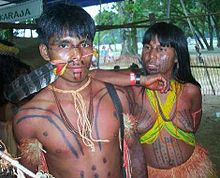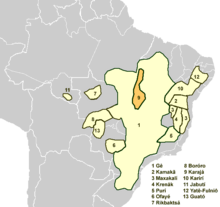Karajá
The Karajá , often also written Carajá (s) , are an indigenous people who live in the area of the Rio Araguaia in the Brazilian states of Mato Grosso , Goiás , Tocantins and Pará . The name used by the tribe is Iny . Your language belongs to the Macro-Jê language family ; it is called Inyrybe ( German The language of Iny ).
The tribe is divided into three groups: The Iny mahãdu (sometimes also Carajá although only a subgroup of the tribe), the Ixãju mahãdu (also called Javaé ) and the Ixãbiòwa (also called Xambioá ).
A distinctive sign of the Karajá are the two circles that they tattoo on their cheeks below the eyes.
territory
The Karajá traditionally populate a 300 km long area in central Brazil on the banks of the Rio Araguaia in the municipality of Aruanã , the island of Bananal , with the largest number of villages, and near the city of Santa Fé do Araguaia .
history
The first encounter between the tribe and European explorers took place in 1673. In 1811 the Brazilian Empire, based in Rio de Janeiro, waged war against the Karajá and neighboring tribes. The Karajá and the Xavantes retaliated with the destruction of the military base Santa Maria do Araguia in 1812. From the middle of the 20th century, the tribe was placed under protection by the Serviço de Proteção aos Indios (SPI).
In the 1980s and 1990s, Karajá leader Idjarruri Karajá fought for better education, land rights and employment opportunities for the tribe. He managed to bring electricity and telecommunications to his tribe in 1997.
Individual evidence
- ^ Synonyms: Carajás and Karajá
- ↑ a b Karajá Iny. Museu do Índio, accessed September 10, 2019 (Brazilian Portuguese).
Web links
- Demográfica dos povos indígenas: Karajá, Javaé e Xambioá, ... (PDF file; 41 kB)
- Diccionario etnolingüístico ... Karajá (PDF file; 162 kB)
- Karajá culture (English)
- Karajá do Norte




